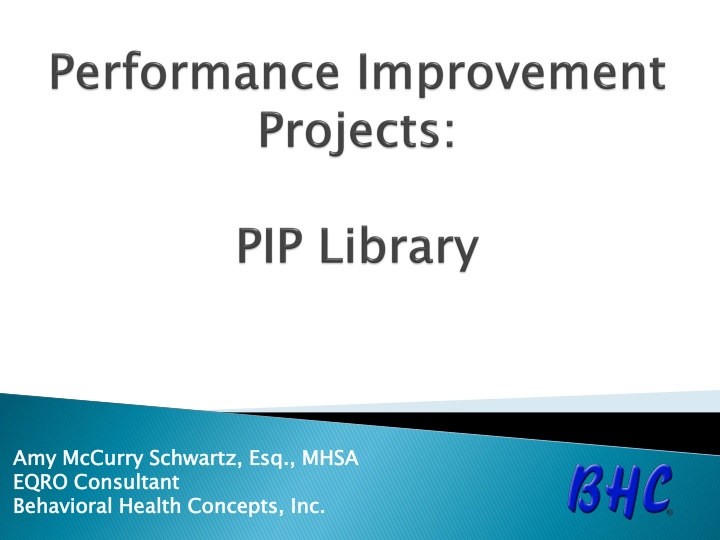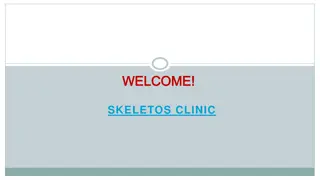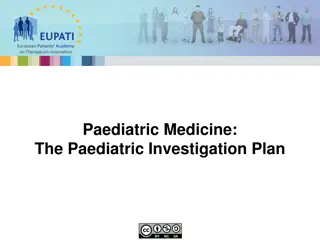
Performance Improvement Projects (PIPs) in Healthcare
Learn the importance of PIPs in assessing and enhancing healthcare processes and outcomes. Discover how clinical and non-clinical PIPs target different aspects of care delivery, and explore resources for PIP development and validation.
Download Presentation

Please find below an Image/Link to download the presentation.
The content on the website is provided AS IS for your information and personal use only. It may not be sold, licensed, or shared on other websites without obtaining consent from the author. If you encounter any issues during the download, it is possible that the publisher has removed the file from their server.
You are allowed to download the files provided on this website for personal or commercial use, subject to the condition that they are used lawfully. All files are the property of their respective owners.
The content on the website is provided AS IS for your information and personal use only. It may not be sold, licensed, or shared on other websites without obtaining consent from the author.
E N D
Presentation Transcript
Amy McCurry Schwartz, Esq., MHSA EQRO Consultant Behavioral Health Concepts, Inc. Amy McCurry Schwartz, Esq., MHSA EQRO Consultant Behavioral Health Concepts, Inc.
The purpose of PIPs To assess and improve processes, and thereby outcomes, of care. 42 CFR 438.240(d) defines PIPs as having a focus on clinical and non-clinical areas.
Clinical PIPs Might Target Prevention and care of acute and chronic conditions High-volume services High-risk procedures Special health care needs
Non-Clinical PIPs Might Target Coordination of Care Appeals, Grievances Process Access or Authorization Member Services
PIP Videos Bringing Ideas to Successful PIP Concept PIP 101 series #1 From Idea to PIP SUD Example PIP 101 series #2 Tips and Common Mistakes PIP 101 series #3
PIP Clinic Webinars and Presentations Webinar recording (when available) PowerPoint presentation Slides
PIP Development by Validation Step CMS EQR Protocol 3: Validating Performance Improvement Projects (PIPs) https://www.medicaid.gov/medicaid/quality-of- care/downloads/eqr-protocol-3.pdf
The PIP should target improvement in either clinical or non-clinical services delivered by the MHP. Study topics must reflect consumer characteristics including demographics, prevalence of disease, and the potential consequences of disease. The topic should address a significant portion of the enrollees (or a specified sub-portion of beneficiaries) and have the potential to significantly impact consumer health, functional status, or satisfaction.
Step 1 Select and Describe the Study Topic and Methodology San Luis Obispo Clinical PIP Integration of Mental Health and Substance Use Screening and Assessment PIP Narrative (as supplied by the MHP) PIP Validation Tool (as scored by BHC) https://caleqro.com/pip-library
Study Questions should be stated in a way that: Supports the ability to determine whether the intervention has a measurable impact for a clearly defined population The study question should focus on the outcomes for the consumer.
Step 2 Define and Include the Study Question(s) Santa Theresa Clinical PIP Seeking Safety Implementation PIP Narrative (as supplied by the Example MHP) https://caleqro.com/pip-library
The PIP must clearly identify the system or population, also referred to as the universe. Once the population is identified, the MHP will determine whether to study data for the entire population or a sample of that population.
Step 3 Identify Study Population San Diego Non-Clinical PIP Client Engagement after Discharge from a Psychiatric Hospital PIP Narrative (as supplied by the MHP) PIP Validation Tool (as scored by BHC) https://caleqro.com/pip-library
A study indicator is a measurable characteristic, quality, trait, or attribute of a particular individual, object, or situation being studied. Each PIP should have one or more measured indicators to track performance and improvement over a specific period of time.
All measured indicators should be: Objective; and Clearly defined; and Based on current clinical knowledge or health services research; and Consumer outcomes (e.g., health or functional status, consumer satisfaction); or A valid indicator of these outcomes.
Step 4 Select and Explain the Study Indicators Sacramento Non-Clinical PIP Implementing a Streamlined E-Scheduling Tool to Increase Timeliness to First Offered Appointment PIP Narrative (as supplied by the MHP) PIP Validation Tool (as scored by BHC) https://caleqro.com/pip-library
A sample is a statistical subset of a population that represents the entire population. Appropriate sampling is necessary to ensure valid and reliable information. Please refer to Appendix II of the EQR Protocols for an overview of sampling methodologies applicable to PIPs. Contact your Quality Reviewer for additional information if needed.
Step 5 Sampling Methods PIP to be added at a later date. https://caleqro.com/pip-library
Data collection procedures must ensure that the data used to measure performance are valid and reliable. Valid data measure what is intended to be measured, while reliable data produces consistent results. To ensure both validity and reliability, the data collection plan should specify: The data to be collected; The data sources; How and when the data are to be collected; Who will collect the data; and Instruments used to collect the data.
Step 6 Sonoma Non-Clinical PIP Enhancing Timeliness of Assessments and Treatments for Youth and Families PIP Narrative (as supplied by the MHP) PIP Validation Tool (as scored by BHC) https://caleqro.com/pip-library
In this step, the reviewer determines the accuracy of the MHP s plan for analyzing and interpreting the PIP s results. Accurate PIP data analysis is critical because the MHP will implement changes in treatment and operations based on the results of a PIP.
Step 7 Orange Clinical PIP Increasing rates of step-down to ongoing care following hospital discharge PIP Narrative (as supplied by the MHP) PIP Validation Tool (as scored by BHC) https://caleqro.com/pip-library
An improvement strategy is defined as an intervention designed to change behavior at an institutional, practitioner, or beneficiary level. The effectiveness of the intervention activity or activities is determined by measuring the MHP s change in performance, according to predefined quality measures.
Interventions are key to a PIPs ability to bring about improved health care outcomes. Appropriate interventions must be identified and/or developed for each PIP to assure the likelihood of effecting measurable change. If repeat measures indicate that quality improvement actions were not successful (i.e., did not achieve significant improvement), the problem-solving process should begin again with data analysis to identify possible causes and propose and implement solutions. If the quality improvement actions were successful, the new processes should be standardized and monitored.
Step 8 San Diego Clinical PIP Therapeutic Homework PIP Narrative (as supplied by the MHP) PIP Validation Tool (as scored by BHC) https://caleqro.com/pip-library
Determining the likelihood that the results of the PIP are accurate. It is important to determine if a reported change represents real change or is a result of a short-term event unrelated to the intervention, or simply random chance. Real improvement can be assessed in several ways, but is most confidently assessed by calculating the degree to which an intervention is statistically significant .
Step 9 Tuolumne Clinical PIP Engaging Clients through the Intake and Assessment Process PIP Narrative (as supplied by the MHP) PIP Validation Tool (as scored by BHC) https://caleqro.com/pip-library
If real change has occurred, the project should be able to achieve sustained improvement. Sustained improvement is demonstrated through repeated measurements over time.
PIP Excellence - Examples of PIPs that were successfully implemented. Clinical San Diego Therapeutic Homework Non-Clinical San Diego Client Engagement after Discharge from a Psychiatric Hospital PIP Narrative (as supplied by the MHP) PIP Validation Tool (as scored by BHC) https://caleqro.com/pip-library
Amy McCurry Schwartz, Esq., MHSA EQRO Consultant amy.mccurry@bhceqro.com 855-385-3776 x103 Amy McCurry Schwartz, Esq., MHSA EQRO Consultant






















